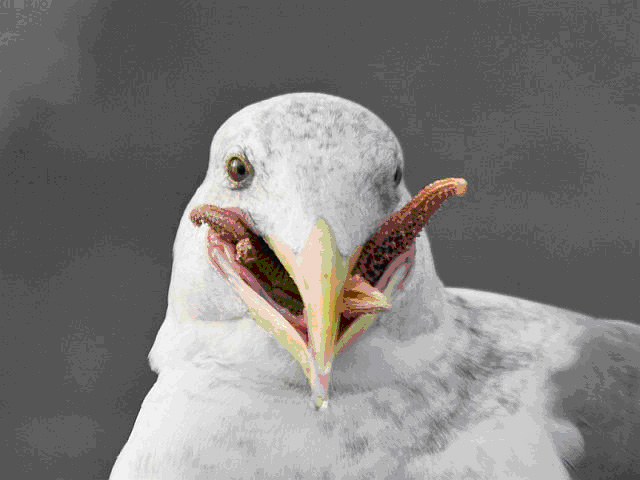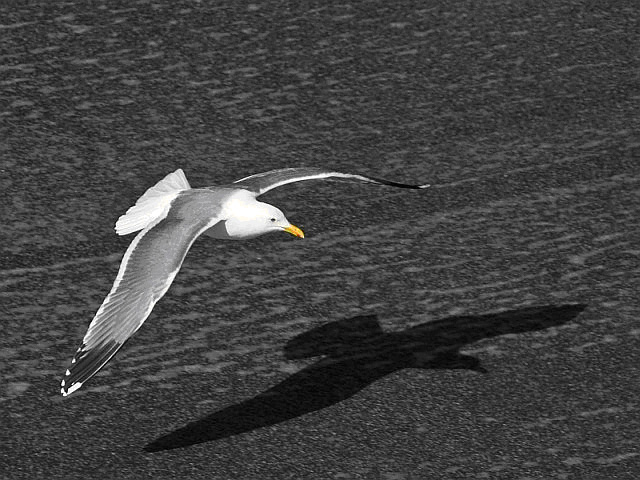
All photos for this article taken by Ron LeValley
www.LeValleyPhoto.com
On Heeser Drive in Mendocino Headlands State Park you will see Western Gulls slide along the wind as it rises up the bluff, wheel around and angle back in the opposite direction. They roost and nest on two rocks north of Goat Rock. How do they turn from windward to leeward without a single flap of their wings? Careful observation of the Western Gulls on those bird-burdened islands will show you that until late April, when land birds are already raising young, they roost overnight and disperse to their feeding area early in the morning. A week later, they enter the nesting mode and stake out territories by perching all day on the rock. Your observer’s notebook reveals courtship behavior such as neck stretching by the end of April. Once the breeding season starts, white-headed adults banish the browner juveniles. In fact, breeding Western Gulls chase away any outsider, even much larger Brown Pelicans.
By the middle of May you will observe the arrival of the first nesting material, and a week later you will see an adult standing in the nest defending it against all comers. Gulls are so common you might think that many species of them nest here but that is not the case, only the Western Gull breeds on the Northern California Coast. Not so much a sea gull as a coast gull, it rarely ranges more than a few miles inland or 25 miles out to sea. The exclusively marine range of the Western Gull, from Washington and British Columbia to Baja California gives some concern because it is limited compared to other gulls.
Characteristics of this species include the dark gray back with black wingtips, the bright pink legs, the large yellow bill with a red spot near the end of the lower bill that chicks peck to stimulate feeding, and a variable but mostly amber colored eye. The wings show black primaries with white tips and a single white mirror on the outermost primary. The wingspan measures about four and a half feet and the body about 21 inches. In addition, the Western Gull keeps its white head through the winter, the only species of gull to do so. The flat forehead and large bill give the Western a “mean” appearance.
It nests from Washington to Baja on offshore islands and rocks such as those off Heeser Drive. For the lifetime of the male, long-term pairs aggressively defend territories whose borders may shift slightly from year to year. Those same Western Gulls you observe today may have been nesting there for up to twelve years typically, or even up to 20 years in some cases although there has been a general shift in the past two years from the larger, outer island, to the smaller, inner one.
The Western Gull builds its nest in colonies. It consists of a scrape in the ground filled with vegetation, feathers, rope, plastic, or other items. They lay three light buff or, greenish, eggs with dark blotching and incubate them for a month. The chicks may leave the nest cup at one day old, covered in cryptically covered down. Chicks remain inside the territory until fledged, for, if they stray into another gulls domain, the neighbor may kill them. Chick mortality is high with an average of one chick surviving to fledging.

An opportunistic feeder, the Western Gull resembles a teenage boy at an open refrigerator. They scavenge refuse, steal food from seals or other gulls, even from Brown Pelicans, and steal milk from seals lying on their backs sleeping on the beach. The photo above, although it is probably an intergrade or hybrid between a Western Gull and a Glaucous-winged Gull, illustrates the wide angle at the corners of the bill which allows it to swallow large prey whole, in this case a Sea Star.
Western Gulls feed in pelagic and inter-tidal environments. At sea, they take fish and invertebrates like krill, squid and jellyfish exclusively on the surface since they cannot dive. On land, they feed on seal and sea lion carcasses, cockles, limpets and snails in the inter-tidal zone. They also take food from people at beaches and marinas. Some Western Gulls prey on the young of other birds and even adults of smaller species and some rob competitors of their prey.
Numbers fell precipitously in the nineteenth century when egg collectors supplied the growing city of San Francisco. Contamination from pesticides and habitat loss decimated this species in the mid 20th century. Today, the Farallon Island, 35 miles west of Bodega, support the biggest Western Gull colony.
Experts refer to the Western Gull as a four-year gull, meaning it takes that long to reach maturity. They separate juveniles into first, second and third years by the color of their feathers, which progresses from brown to white and grey, the black legs quickly become pink, and the bill color changes from black to pink.
Spend a little time on Heeser Drive observing their behavior and you will see the young peck at the red spot on the adult bill. Later you will catch brown juvenile and white-headed adult alike, glide effortlessly in the rising air current along a bluff and wonder how they do it.

Back to ... Mendocino Coast Audubon Society Newsletter Articles | Home page